WORD PROCESSOR: HIGHLIGHTS FROM THE COLLECTION
October 13, 2011
A Brief Study of the Study of Splashes
Christian Hawkey
In 1895 Alfred Jarry, the Paris-based French author of the famed absurdist play Ubu Roi and inventor of 'pataphysics' (described by him as "the science of imaginary solutions" where "every event in the universe is accepted as an extraordinary event") published a play titled Caesar Antichrist, in which a character asserts: "I can see all possible worlds when I look at only one of them. God—or myself—created all possible worlds, they coexist, but men can hardly glimpse even one." In May of 1894, a year earlier, the English physicist and educator A. M. Worthington delivered a lecture at the Royal Institute of London. Worthington was 42 years old. He was one of a handful of late 19th century scientists who had become famous for studying and measuring microscopic natural phenomenon using small time intervals. His lecture title: "The Splash of a Drop and Allied Phenomena."
Science, we know, is fiction, and technology (as well as mathematics) is often deployed as a means to represent that fiction as science. At the turn of the century the boundaries between science and fiction, between art and scientific documentation, between the lexicons of scientific inquiry and everyday speech, and between the categories of artist and scientist, were not yet defined or separated out into rigid categories. Jarry's creation of 'pataphysics—a kind of pseudoscience—was in part meant to critique and therefore resist what he saw as a new and worrisome trend toward the specialization of scientific language and experimentation, and this is one reason he was seen as proto-Dadaist and subsequently celebrated by the Surrealists: his resistance aligned with the newly consecrated avant-garde mission to break down the fixed and rigid borders between the various rarefied regimes and institutions of the arts that "Royal Academies" or coterie-based "art for art's sake" movements had erected in the early and mid 19th century.
Another hybrid artist-scientist, pioneer of underwater photography and film, Jean Painlevé, was celebrated by the Surrealists for similar reasons; his otherworldly films of vampire bats, skeleton shrimp, or of a male sea horse giving birth, thrilled both marine biologists and experimental filmmakers. If, as Walter Benjamin argued, 19th century means of mechanical reproduction dispersed art's "aura" of authenticity, then it seems as if the mechanism of science was there to reinstate it, or at least maintain it, so that the work of hybrid artists like Painlevé—or Muybridge, or Man Ray, or Audubon—preserves its reified status despite reproducibility. This is a perennial question; when we look at Robert Hooke's 1665 disconcertingly elegant drawing of a flesh-biting flea seen under the lens of a microscope, we don't immediately question whether it's document or wondrous art. It's both.
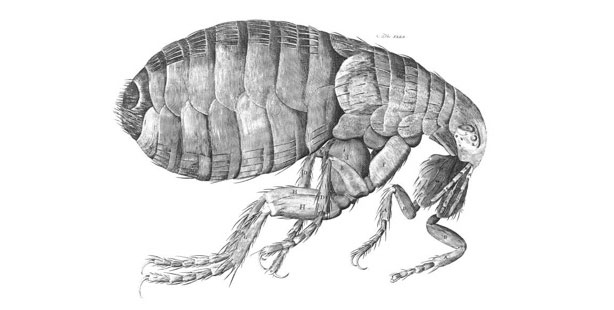
A. M. Worthington's 1894 lecture on "The Splash of a Drop and Allied Phenomena" is especially interesting because even though photographic technology was available at the time, he chose, at first, to document his microscopic study of "the splash" with drawings. This was in keeping with an early scientific distrust of photography, which was rooted in a Linnean notion of type and taxonomy and which saw photographs more as a record of a single entity than as a record of a given phylum, class, order, family. But how do you make a scientific drawing of an instantaneous and ephemeral event like a splash? How do you make a series of drawings that show in great detail the millisecond progressions of a drop of mercury falling on a flat, hard surface? How do you even "glimpse" this world, let alone draw it?
Worthington's answer was simple: he turned himself into a camera. He created a device that released at fixed intervals drops of mercury on a flat surface, and then set up a second electrical device that generated a lightening-quick flash of light—essentially a flash bulb—which, when timed with the impact of the drop, briefly but clearly illuminated a single instant. Worthington writes: "The problem . . . was . . . this: To let a drop of definite size fall from a definite height in comparative darkness onto a surface, and to illuminate it by a flash of exceedingly short duration at any desired stage. . . The flash must be bright enough for the image of what is seen to remain long enough on the eye for the observer . . . to make a drawing of what is seen."
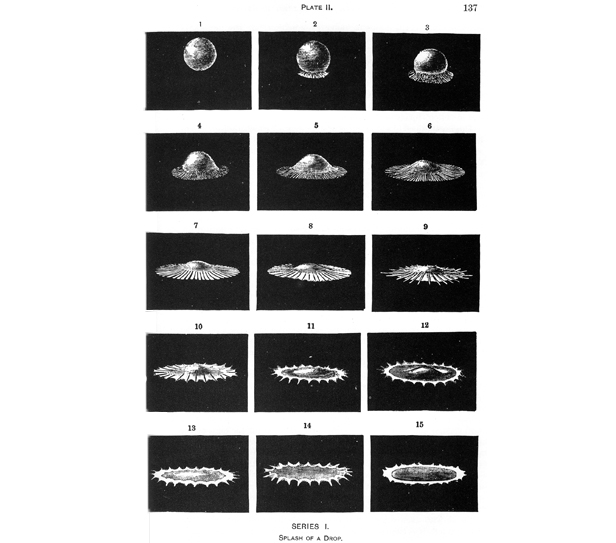
How many times did he have to conduct this experiment? How long did he have to sit in the dark? It's no accident that Worthington's hero was the mid-19th century blind Belgian scientist and mathematician Plateau, who invented the phenakisticope, an early device for animation and precursor to the invention of cinema that used the persistence of vision to create the appearance of motion. Like Worthington he conducted pioneering studies of surface tension in liquid masses, discovering why water (from a faucet, for example) will break up into droplets of equal size. Plateau's work on the surface tension of liquids inspired another British scientist: C. V. Boys. Boys worked with high-speed photography (he was the first to photograph a bullet in flight) to examine the surface tension and liquid properties of soap bubbles. He was a colleague of Worthington's—they were born three years apart—and the 1890 book that resulted from his research and public lectures, Soap Bubbles: Their Colours and the Forces Which Mould Them, is so popular that it's still in print. As it happens, this book had a great influence on none other than Alfred Jarry, who modeled the main character of his posthumously published novel, Exploits and Opinions of Dr. Faustroll, pataphysician, after Boys. A half-century later the American poet Elizabeth Bishop, whose work is famed for its precise and sustained attention to the microscopic details of everyday life (during WWII she took a job grinding binocular lenses), claimed that Boys's Soap Bubbles taught her more about close observation and seeing than most poetry.
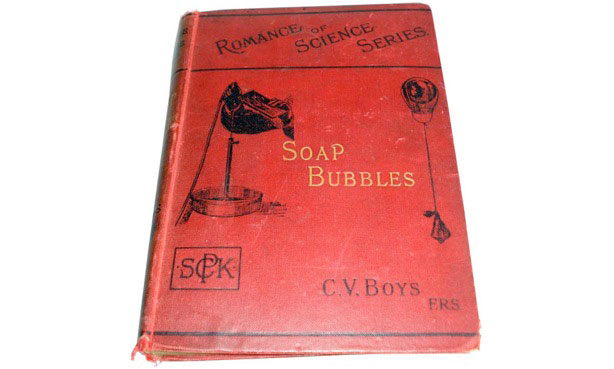
"Romance of Science." The series title says it all. The late 19th century was the golden age of scientific popularization (and this was the same moment that scientific knowledge and experimentation started to become increasingly institutionalized). Whereas Enlightenment-era European scientists were mostly divided between academy-based natural philosophers and itinerate pseudo-scientific lecturers and instrument makers, trained scientists could now hold public lectures—and print books—explaining, for example, how steam engines worked. Or soap bubbles. Or the event of fluid mechanics that occurs when a drop of water lands on a hard or liquid surface.
Paging through Worthington's book, A Study of Splashes (1908), which expands upon (and includes) his 1894 lecture, it's easy to imagine Worthington's—and a contemporary viewer's—sense of wonder at a previously invisible "possible world" suddenly made visible. After his lecture and initial drawings, and with key technological help from his friend Boys, Worthington abandoned his drawings and took to photographing his spark-illuminated investigations of splash formation; the book contains countless reproductions of an astonishing array of different splashes, as well as millisecond renderings of each stage of a given splash. And in keeping with scientific populism, the "real" is located in the ordinary, the everyday surface that exists before our eyes. Chapter I begins: "There will be but few of my readers who have not, in some heavy shower of rain, beguiled the tedium of enforced waiting by watching, perhaps half-unconsciously, the thousand little crystal foundations that start up from the surface of a pool or river; noting now and then a surrounding coronet of lesser jets, or here and there a bubble that floats for a moment and then vanishes."
Worthington from the outset addresses not the scientist but the common reader and observer of the natural world, with whom he hopes to share "some of the delight I have myself felt, in contemplating the exquisite forms that the camera has revealed." Yet his book is really less about form in the general sense than about the construction of narrative, and specifically about the construction of a form which makes sequence and causality believable; it's easy to forget, viewing the images, that each captures a different splash, which has then been combined with the others to create the appearance of a single splash in the process of unfolding.
Chapter II is titled "THE SPLASH OF A DROP—LOW FALL" and it documents a drop of water falling into milk mixed with water ("The object of adding milk to the water was to make it [the splash] more visible") from a height of 40 cm (about 16 inches).
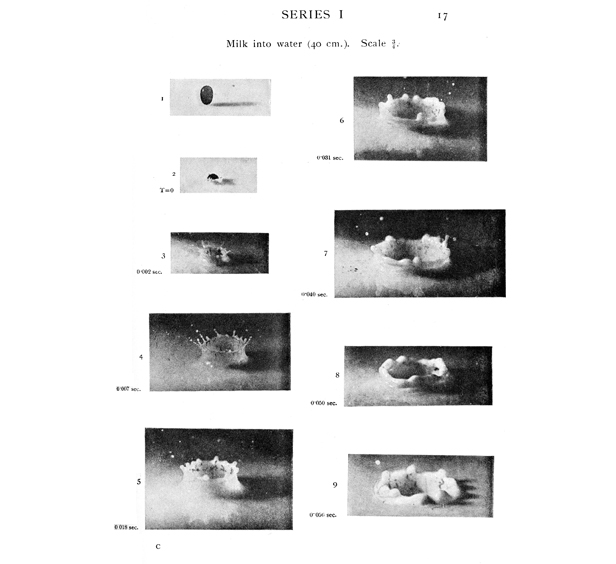
Under the guise of objective inquiry, where a fluid and continuous phenomenon is parceled out into a series of images, what we see in fact is the illusory creation of an object: the splash. This is the fiction that such inquiry—and technology—creates. It doesn't document reality, it produces it. And this is perhaps one reason that Worthington, in his descriptions of his images, is so enthralled. Descriptive language is deployed to re-describe what is already visually narrated, as if, via Derrida's idea of the "re-mark," something must be inscribed twice in order to be believable, to exist: "The crater which rises with great rapidity up to Fig. 4. In Fig. 5 the walls are beginning to grow thicker, while the next three figures show the crater subsiding and widening, till in Fig. 9 it lies as a mere ring of lobes on the surface, surrounding a central hollow." The next page documents "the beginning of the rebound":
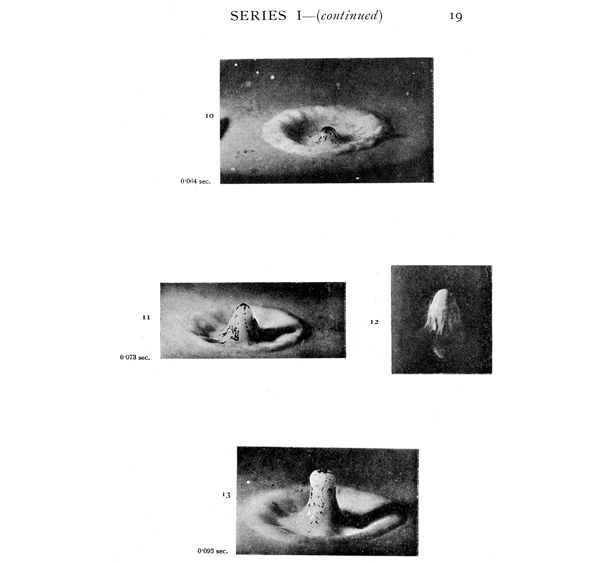
Charmingly, one senses Worthington's enthusiasm in his use of italics: "It will be seen that the lamp-black [residue left-over from the drops sliding down a heated tube] is now all swept to the middle, indicating that the liquid of the original drop emerges at the head of the central column." It's not precisely clear why this matters, but one gazes at the photographs with heightened scrutiny. Worthington goes into detail about the appearance of secondary columns, the size and shape of primary and secondary craters, the various circular ripples that extend outwards and advance into "smaller ripples travelling with greater speed," and he concludes: "Let the reader when he next receives a cup of tea or coffee to which no milk has yet been added, make the simple experiment of dropping into it from a spoon, at the height of fifteen or sixteen inches above the surface, a single drop of milk." One can conduct this experiment anywhere (although note his dated use of the masculine pronoun, as if science and even informal experimentation were an exclusively male domain).
What makes Worthington's book so fascinating is that he documents the phenomenon of the splash with a zeal that can only be described as obsessive[1]. The next series of photographs documents a water drop falling into water; he croons lovingly over the fact that sometimes the outer edge of the crater is only visible in the reflection captured on the surface of the water (reflections multiply the form, thereby confirming the narrative). He cleans the surface of each pool of water before adding and photographing another drop, so that we can better see the "play of light" over the water's surface ripples. He varies the height of the fall. He varies the size of the drop. He varies what is dropped by moving on to marbles, which prompts a discussion between different splash formations created by polished or non-polished marbles ("If the polishing has been good, and the surface of the sphere has not been dimmed by subsequent handling with hot or greasy fingers, it will be observed that the splash is singularly insignificant. . ."). In Chapter V he notes that higher falls generate "bubble-building," where the crater created by the splash closes its "mouth" so as to form a bubble on the surface of the liquid:
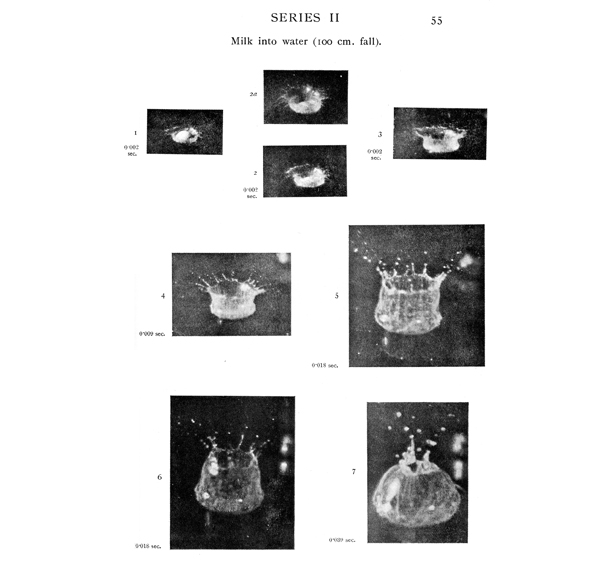
In Worthington's documentation and narration the splash is not only turned into a singular object, it is also anthropomorphized: the bubble now has "a mouth" and the tendrils of water spring from the crater rim are called "arms." Microscopy, the limits of opticality, and scientific inquiry become extensions for and of the body—a desire to figure knowledge, embody it. This figure of the body that haunts science, and image and text (in general), is most easily seen in today's equivalent of popularized science: forensic and hospital TV shows, from the "CSI" franchise to "House," where microscopy and digital enlargement endlessly recreate the fiction of the body—and the corpse—as the site upon which truth (and the law) depends.
It's not just Worthington's black and white photographs or the highly aesthetic framing and display—images arrayed on the gallery wall of the page—that give one the feeling that these are 'pataphysical "afterworld" splashes, haunted ghost splashes, unreal splashes, the splashes of a previously invisible and therefore uncanny world. Worthington himself ends the book with a series of images that purport to be the shadows of splashes—trace shadows and the splashes' after-image:
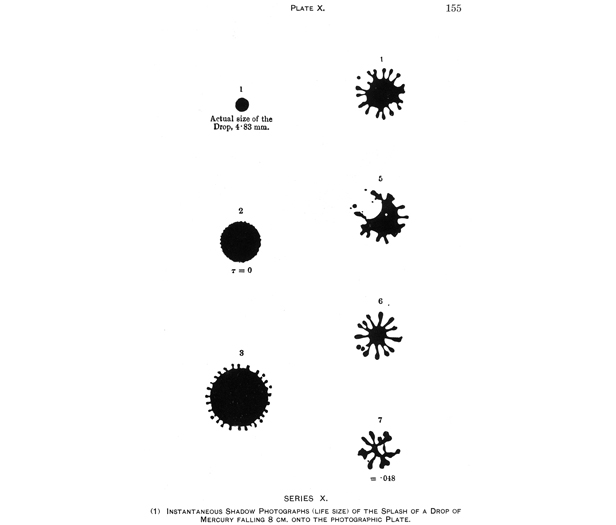
In his conclusion to the book, Worthington is momentarily wracked by doubt: "But even were the photographic record complete, what does it amount to? All that we have done has been merely to follow the rapid changes of form that take place in the bounding surface of the liquid. The interior particles of the liquid itself have remained invisible to us." After marshalling text and image into an examination of the essence of a splash, and with essence identified as that which is interior (a basically religious notion of the body), Worthington seems to realize that the search for essences, for the interior, is infinite—as infinite, in fact, as the splashes and the ever-more minute objects the search for them generates. This sudden fit of doubt in the conclusion is followed by a reference to the book's beginning, the image which serves as its frontispiece, and with this image Worthington suggests that his project might have practical applications to the world of physics outside of his drops of water. It's the strangest image in the book, and it illustrates the "surface tension" that runs through this astonishing book: the desire for permanence among an infinite number of impermanent worlds.
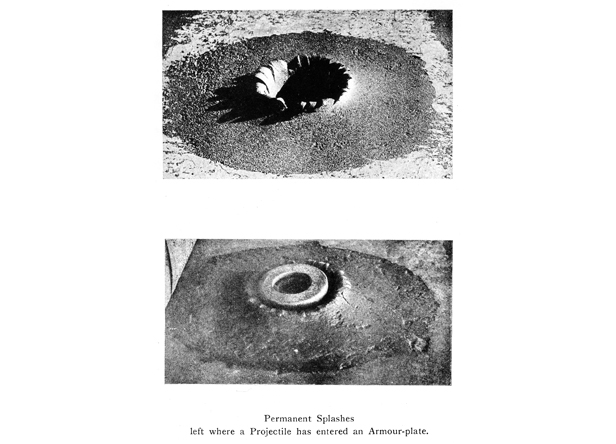 _________________________________________________________________
_________________________________________________________________
[1]
A note about scientific obsession. One reason Painlevé's work can be framed as Surrealist (even though he resisted the affiliation) is because he foregrounded (however problematically) the role of desire and sexuality within scientific inquiry, observation, and obsession. In an essay titled "Feet In The Water" (1935), Painlevé writes about the sensuality of wading: "Wading around in water up to your ankles or navel, day and night, in all kinds of weather, even in areas where one is sure to find nothing, digging about everywhere for algae or octopus, getting hypnotized by a sinister pond where everything seems to promise marvels although nothing lives there. This is the ecstasy of any addict." Worthington would never have described his obsession with splashes as the "ecstasy of an addict," and he is much too Victorian and restrained to admit sensuality into his investigation of the phenomenon of the splash, but from our only slightly more informed present, where there is no such thing as "objectivity," and where any given subject position can be read through the frame of sexuality (or gender, race, class), it's hard to miss the fact that Worthington's obsession with "annular rims" and "viscous fluids" (projected through air only to encounter hard surfaces or pools of maternal milk), began when he conducted experiments as a boy with a classmate named H. F. Newall. Newall's own classroom observations of a mercury bead spattering on a flat surface is credited in the book as having inspired Worthington to pursue his subject, and his book opens with a dedication to Newall: "IN [REMEMBRANCE] OF THE ENCOURAGEMENT GIVEN TO THE EARLY OBSERVATIONS MADE IN BOYHOOD BY MY OLD SCHOOL-FRIEND H. F. NEWALL FROM WHICH THIS STUDY SPRANG." Homoeroticism? Or just late-Victorian naïveté? One wonders how Freud, who was writing around the same time, would have read this book.
Christian Hawkey is the author of two full-length poetry collections (The Book of Funnels and Citizen Of ), numerous chapbooks, and (most recently) the cross-genre book Ventrakl. In 2006 he received a Creative Capital Innovative Literature Award. In 2008 he was a DAAD Fellow. He lives in Berlin and Brooklyn.
View A Study of Splashes in the catalog.
